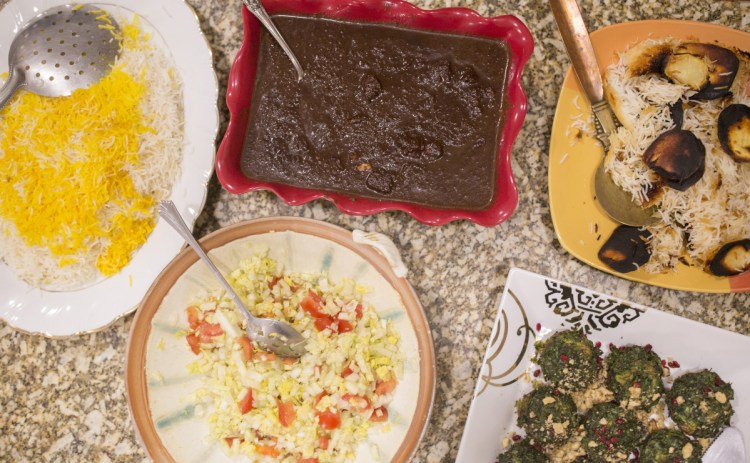KOOKOO SABZI
This recipe comes from Portland resident Parivash Rohani; the dish is often served during the Persian New Year. Traditionally made on the stovetop, kookoo sabzi can also be divvied up among a dozen muffin cups and baked in a 450-degree oven until it starts bubbling and sets on top, about 10 minutes. Rohani recommends garnishing each serving with crushed walnuts, Persian berries, or craisins.
Serves 8
1/2 cup neutral oil, such as grapeseed
1 teaspoon ground turmeric
1 white onion, finely chopped
3/4 cup fresh flat-leaf parsley, finely chopped
3/4 cup fresh dill, finely chopped
1/2 cup fresh basil, finely chopped
1 cup spinach leaves, finely chopped
6 leaves romaine lettuce, finely chopped
5 scallions, finely chopped
3 eggs
3/4 teaspoon salt
1/4 teaspoon freshly ground black pepper
1 tablespoon all-purpose flour
Flatbread or yogurt, for serving
1. Heat 1/4 cup of the oil over medium-high heat in an 8-inch nonstick skillet. Add 1/2 teaspoon of the turmeric and the onion, and sauté, stirring occasionally, until the onions are lightly browned, 12 to 15 minutes. Add all the greens – the parsley, dill, basil, spinach, romaine and scallions – and stir to combine (the pan will be very full). Still using medium-high heat, wilt the vegetable mixture for about 4 minutes. Transfer to a bowl and set aside. Wash the pan.
2. Whisk together the eggs, salt, pepper, flour and remaining 1/2 teaspoon turmeric in a medium bowl. Add 2 cups of the vegetable mixture and stir to combine completely. If any egg is still puddling at the bottom of the bowl, add more of the vegetable mixture, 1/4 cup at a time, until the egg is fully incorporated. (Save any leftover vegetable mixture for something else, like a scramble.)
3. Return the pan to the stove over medium heat and add the remaining 1/4 cup oil. When it’s warm, add the egg mixture to the pan and quickly spread it into an even layer. Cover and cook, reducing the heat as necessary to maintain a gentle bubble, until the bottom is quite browned but not burned and the top has set, about 10 minutes. With the side of a spatula, divide into quarters. Flip each quarter and continue cooking, covered, until the bottom is browned, 2 to 3 minutes. Cut each quarter in half to make 8 slices. Eat warm with flatbread or yogurt.
FESENJAN
This recipe comes from Portland resident Parivash Rohani; the dish is often made to celebrate the Persian New Year. A special occasion food, fesenjan is traditionally made with duck or pheasant in northern Iran, but you can also use chicken, or even small meatballs. It is a thick, rich, sweet-sour dish that improves when made a day ahead. Find pomegranate syrup in most Middle Eastern and health food stores or use an equal amount of frozen, concentrated cranberry juice. Iranian cooks use butter, Rohani says, but she uses olive oil for health reasons.
Serves 6-8
1/4 cup olive oil or 4 tablespoons butter
2 small onions, sliced thin
21/2 cups walnuts, finely ground
2/3 cup pomegranate syrup
21/2 cups chicken stock or water
2 tablespoons sugar
Salt to taste
2 teaspoons pepper
11/4 teaspoons saffron, optional
21/2 to 3 pounds bone-in, cut-up poultry of choice
Juice of 2 limes, or as needed
White rice for serving
1. Heat the butter or oil over medium heat in a large Dutch oven. Add the onions and sauté until wilted and translucent, about 10 minutes.
2. Stir in the ground walnuts, pomegranate syrup, stock, sugar, salt, pepper and saffron, if using. Adjust the sugar and salt to taste. Bring the mixture to a low boil and simmer for 1/2 hour.
3. Add the poultry and simmer on low heat another 30-60 minutes until the sauce thickens and reduces. Halfway through the cooking time, add the lime juice to taste. The sauce will thicken and darken during this cooking time, and the oil will begin to render out of the walnuts. Add more water or stock if necessary to prevent the sauce from thickening too much and scorching.
4. Serve with plain white rice.
PERSIAN RICE
This recipe comes from Portland resident Parivash Rohani, and is often on the table at the Persian New Year. Rohani often lines the pan with a few slices of potato, before topping it with the parboiled rice, so she gets crispy potatoes to serve as well as crispy rice. (Other Iranian cooks use other vegetables for the tahdig, she said, or even pita bread.) Also, she often sets a small bowl with about 3/4 cup water and a little saffron on top of the rice while it’s cooking so the saffron’s color diffuses into the water. When the rice is ready, she pours the yellow water over it and stirs. This ensures the saffron colors and flavors the rice evenly.
Serves 4 to 6 as a side dish
2 tablespoons salt
11/2 cups long-grain rice (not converted; preferably basmati or jasmine)
3 tablespoons unsalted butter
1. Bring 2 quarts of water with the salt to a boil in a large saucepan. Add the rice and boil 10 minutes. Drain the rice in a colander and rinse under warm water.
2. Melt the butter in a 2- to 3-quart nonstick saucepan. Spoon the parboiled rice over the butter, and cover the saucepan with a kitchen towel and a heavy lid. Fold the edges of towel up over lid so it doesn’t catch on fire, and cook the rice over moderately low heat until tender and a crust forms on bottom, 30 to 35 minutes.
3. Spoon the loose rice onto a platter and dip the bottom of the saucepan in a large bowl of cold water for 30 seconds to loosen the tahdig, the coveted crispy layer at the bottom. Remove the tahdig to the platter to serve with the rice.
Send questions/comments to the editors.


